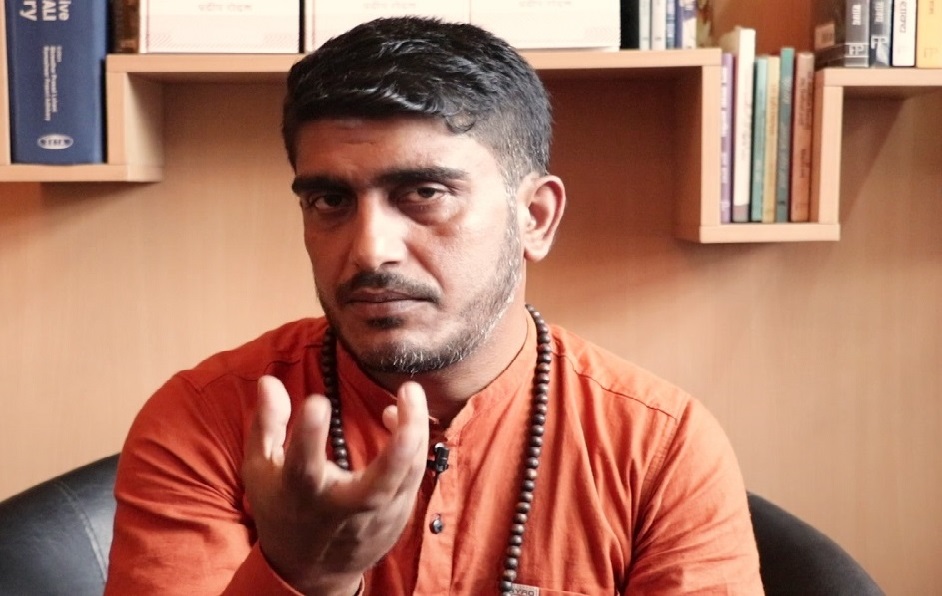Renowned in Nepali literature as Pradip Rodan, ghazal artist Pradip Pandey, 37, originally from Gorkha, has written several famous ghazals, such as ‘Bhagawan Tapaile Aaja Samma Malai Ruwaunu Bhayo’, ‘Pithunma Dhap’, ‘Aafnai Nam ra Thar Ta Chhutiyera Baseko Chha’ and many more. In 2016, he received the ‘Lokpriya Ghazalkar Award’, followed by the ‘District Youth Literature Award’ two years later.
In 2023, he was awarded the ‘Nagar Sahitya Samman-Gorkha’ and the ‘Uttam Best Poetry Award’ for his ghazal collection ‘Muffler’. In addition to his writing endeavors, Rodan teaches at Dharmodaya Secondary School in his hometown.
Babita Shrestha from ApEx spoke to Rodan about his journey as a ghazal writer.
What drew you to ghazals?
I had no knowledge of ghazals until I was 30 years old. In 2003, I started teaching but I wasn’t satisfied with what I was doing. After four years, I ran a radio program for six years. But it didn’t fulfill me either. Later, I attended a program in Abu Khaireni and I came across Ramesh Bhatta Sadhu’s ghazal. He graciously offered to help me perform ghazals. I used to sing lok dohori in the village so I gave it a shot. In 2016, one of the institutions dedicated to promoting ghazals, hosted a competition and I submitted a ghazal. It got selected among the top 12, earning me an award. The sight of the award motivated me to write more and eventually, ghazals became the purpose of my life.
How do you approach ghazal-writing and choose the themes for it?
Things around me trigger me to write. For me, it’s not just about writing a ghazal but also expressing how I perceive things. Maybe because I grew up in a rural place, the surroundings inspire me, and I channel the imagery and emotions into my ghazals. In my work, I use simple words so that everyone can understand the emotion behind them. Mostly I write on the themes that revolve around the reality of society, the essence of life, and the inevitable sorrows. I don’t think too much when I write. I try not to rationalize my feelings.
What do you enjoy the most about being a ghazal artist?
The most enjoyable aspect is when I feel capable of capturing the essence and originality of life that transcends time. During recitations, I enjoy being able to captivate the audience with the intensity of emotions. I remember the time I performed for the first time at Gorkha bazaar when I presented some of my early ghazals like ‘Payena Bhaney Maya Manako’ and a few others. It was such a memorable experience. People were whistling, applauding, and appreciating my performance. I have to admit that the best part about being a performing artist is the love and appreciation you get from the audience. It is what sustains me and fuels me to write.
Can you tell us a little about the collection you’ve just launched? What was the inspiration behind it?
I have more than half a dozen collections that I have co-authored such as ‘Indreni’, ‘Akchyar Haruko Pyramid’, ‘Ek Kadam’ and many more but recently, I have authored my own ghazal collection called ‘Muffler’. ‘Bango Kadh ma Chadera Chora Hurkiyo’ is one of my favorites. It was inspired by my grandfather and was written on the day of his demise. Before he passed away, he put his arm around his son. He had always been strong and self-reliant. This scene shook me and I wrote about the incident in the ghazal. Another one ‘Chora Mareko Khabar Aama lai Nasunaidinus’ is based on a relative from my hometown who cries for her dead son even after three decades of his passing. Overall, the book is crafted with insights into the realities of life and stems from my observations and experiences, particularly in the face of increasing materialism and harsh traditions.
How can one get into ghazal writing?
Ghazal writing isn’t easy. It requires focus, a sort of devotion, if I might say so, and perseverance. You have to be a student of life as it can teach you a lot, but you also need to learn from the works of other ghazal writers. Life, I believe, is a delicate equilibrium between joy and sorrow, action and consequence. When I write, I want to maintain harmony which is why I consciously keep my thoughts and emotions attuned to the rhythmic flow. I find comfort in expressing emotion through simple yet heartfelt words, sometimes humming them to match the tune. You have to find and develop your style.

MORE NEWS
Young leadership in choice, Saugat wins with respectable votes
Baglung flood: Three killed as flood sweeps away motorcycle and scooter
‘Youth in slogans many times, Youth in leadership this time’ – Saugat Thapa [Video]
Gandaki minister Deepak Manange resigns after ministry transfer